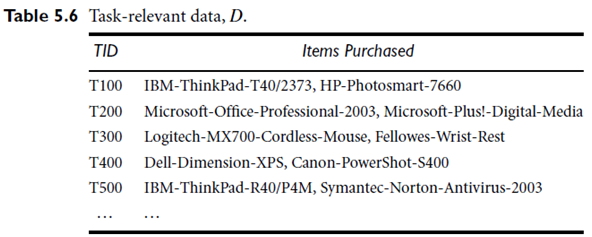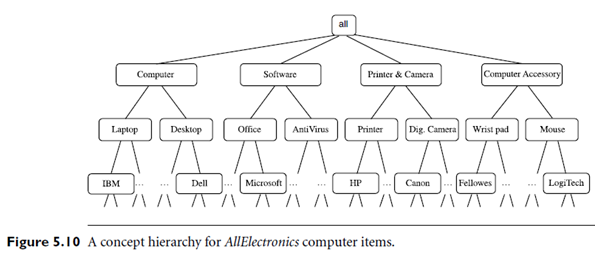Mining Multilevel Association Rules
Introduction: For many applications, it is difficult to find strong associations among data items at low or primitive levels of abstraction due to the sparsity of data at those levels. Strong associations discovered at high levels of abstraction may represent commonsense knowledge. Moreover, what may represent common sense to one user may seem novel to another. Therefore, data mining systems should provide capabilities for mining association rules at multiple levels of abstraction, with sufficient flexibility for easy traversal among different abstraction spaces.
Let’s examine the following example.

Example: Mining multi level association rules. Suppose we are given the task-relevant set of transactional data in Table 5.6 for sales in an All Electronics store, showing the items purchased for each transaction. The concept hierarchy for the items is shown in Figure 5.10. A concept hierarchy defines a sequence of mappings from a set of low-level concepts to higher level, more general concepts. Data can be generalized by replacing low-level concepts within the data by their higher-level concepts, or ancestors, from a concept hierarchy.

The concept hierarchy of Figure 5.10 has five levels, respectively referred to as levels 0 to 4, starting with level 0 at the root node for all (the most general abstraction level). Here, level 1 includes computer, software, printer & camera, and computer accessory, level 2 includes laptop computer, desktop computer, office software, antivirus software, . . . , and level 3 includes IBM desktop computer, . . . , Microsoft office software, and so on. Level 4 is the most specific abstraction level of this hierarchy. It consists of the raw data values. Concept hierarchies for categorical attributes are often implicit within the database schema, in which case they may be automatically generated using methods such as those described in Chapter 2. For our example, the concept hierarchy of Figure 5.10 was generated from data on product specifications. Alternatively, concept hierarchies may be specified by users familiar with the data, such as store managers in the case of our example.
The items in Table 5.6 are at the lowest level of the concept hierarchy of Figure 5.10. It is difficult to find interesting purchase patterns at such raw or primitive-level data. For instance, if “IBM-ThinkPad-R40/P4M” or “Symantec-Norton-Antivirus-2003” each occurs in a very small fraction of the transactions, then it can be difficult to find strong associations involving these specific items. Few people may buy these items together, making it unlikely that the itemset will satisfy minimum support. However, we would expect that it is easier to find strong associations between generalized abstractions of these items, such as between “IBM laptop computer” and “antivirus software.”